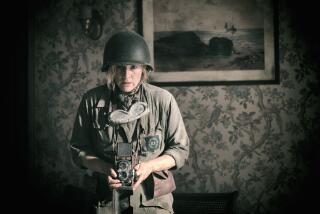Book Review: ‘Lee Krasner’ by Gail Levin
- Share via
Lee Krasner
A Biography
Gail Levin
William Morrow: 532 pp., $30
“I happen to be Mrs. Jackson Pollock, and that’s a mouthful. The only thing I haven’t had against me was being black. I was a woman, Jewish, a widow, a damn good painter, thank you, and a little too independent.”
That’s Lee Krasner in 1973, talking to Newsday journalist Amei Wallach about a landmark event in her career. At 65, Krasner was having her first solo exhibition at a New York museum, a show of 18 large abstract paintings at the Whitney Museum of American Art.
Prickly and proud, Krasner was perpetually in the shadow of her husband, a leading Abstract Expressionist painter and self-destructive alcoholic who left her a widow at 47. Thanks in large part to female advocates, she finally gained recognition as a Modernist master who came of age in Abstract Expressionism’s formative stage. At her death, in 1984, a traveling retrospective of her work was headed for Manhattan’s Museum of Modern Art.
Widely known as it may be, Krasner’s life story — now told in full — is compelling. Art historian Gail Levin, also an expert on artist Edward Hopper, has drawn on her close association with Krasner and extensive research to produce a biography that rings fair and true. As Pollock’s facilitator, Krasner is sometimes dismissed as a martyr or drama queen. In Levin’s biography, she emerges as a fiery creative force whose husband was an asset and an albatross.
Living and working with Pollock transported Krasner to a level she never could have reached on her own in the days when women’s access to artistic power centers was severely limited. But in her self-styled role as his caretaker, gatekeeper, promoter — and eventually estate manager — she devoted much of her life to his professional interests and personal needs.
The child of Russian Jewish immigrants, Krasner was born Oct. 27, 1908, nine months and two weeks after her mother arrived in New York to join her husband. The couple already had four offspring, including a girl who had died. Their sixth and last child, daughter Ruth, was born in 1910.
Krasner grew up among poor immigrants in Brooklyn and blazed her way to what would become the epicenter of contemporary art. Probably inspired by Edgar Allan Poe’s poem “Lenore,” she changed her given name, Lena, to Lenore and later shortened it to Lee. Although she identified herself as Jewish throughout her life, she rejected religious practice at an early age. Her career choice probably didn’t please her parents, but they indulged her desire to become an artist as long as she could support herself. In 1926 she enrolled in the Women’s Art School at the tuition-free Cooper Union for the Advancement of Science and Art in Manhattan.
Krasner’s art education almost ended in 1928, when her older sister Rose died, leaving a husband and two young daughters. Lee was expected to marry her brother-in-law and raise the children. But the willful budding artist refused and the responsibility fell to Ruth, who was next in line.
By the time her younger sister got married to her former brother-in-law, Krasner had moved on to the National Academy of Design and fallen in love with a dashing fellow student, Igor Pantuhoff. She was never a beauty and, at least in later life, seemed to take little interest in her appearance, so it comes as a surprise to read that her lover “began to style and present her to the world like a Pygmalion” in “glamorous clothing and exotic jewelry.” Levin speculates that Krasner was drawn to Pantuhoff’s sophistication and style; he, to her self-assurance and sex appeal.
The artists lived together for several years and worked for the Public Works of Art Project of the Civil Works Administration during the Great Depression. When they split, Krasner was distraught. But Pantuhoff was destined to be a society portraitist. She was bound for glory of a different kind.
In interviews, Krasner recalls struggling in art school and putting up with instructors such as painter Hans Hofmann, who said her work was “so good you would not believe it was done by a woman.” She also describes herself as a “tough cookie.” Tough enough to take on the young, deeply troubled Jackson Pollock.
When she met her future husband, at an Artists Union dance in 1936, he was drunk. But within a few years, the word was out: He was a great painter. By 1942, Krasner was smitten with the shy and introverted man as well as his work. Had she known how violent he could be under the influence of alcohol, it probably wouldn’t have deterred her. In Levin’s words, “Taking care of a man, especially one she viewed as destined to make art history, did not strike Krasner as too steep a price.”
As Krasner pursued her own work, she introduced Pollock to the right artists, critics and dealers. His fame escalated, but he was ill-equipped to deal with success — or failure. In 1956, while driving home with his mistress, Ruth Kligman, and her friend, Edith Metzger, he crashed into a clump of trees. Pollock and Metzger died; Kligman survived.
Krasner survived too. Not peacefully, but long enough to celebrate the 1970s women’s movement as “the major revolution of our time” and to know that her work would be remembered.
A former Times staff writer, Muchnic is the author of “Odd Man In: Norton Simon and the Pursuit of Culture.”
More to Read
Sign up for our Book Club newsletter
Get the latest news, events and more from the Los Angeles Times Book Club, and help us get L.A. reading and talking.
You may occasionally receive promotional content from the Los Angeles Times.










